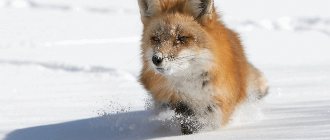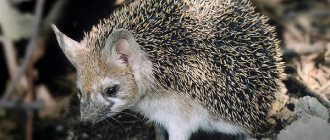- Wild animals
- >>
- Mammals
The Tibetan fox is a very unique representative of flora and fauna. Of all the existing species of foxes, it is the smallest. The unusual color and huge, fluffy tail, as well as the shape of the muzzle and eyes make it recognizable and significantly distinguish it from other representatives of this species. The fox is a predatory mammal that belongs to the canine family. Many note that the appearance of the muzzle makes it incredibly similar to wolves.
Origin of the species and description
Photo: Tibetan fox
The Tibetan fox belongs to the chordate mammals, is a representative of the canine family, allocated to the genus of foxes, the species Tibetan foxes.
The first ancestors of these representatives of the canine family appeared in the Eocene period - more than 50 million years ago on the territory of modern North America. In this area, researchers discovered several types of fossil remains of ancient representatives of the canine family. They belonged to miacidae. Judging by the findings, the ancient ancestors of foxes had a rather elongated body and short limbs. In Europe and modern Asia they were mentioned during the Pleistocene period.
After some time, the ancient ancestors of canines spread over a wider area and divided into two species:
- Canidae;
- Felidae.
The direct ancestor of the Tibetan fox is Progesperocyon. Researchers discovered his remains in the western region of modern Texas. In the process of evolution, this type of predator changed its habitat and, depending on the territory in which it lived, changed.
Links[edit]
- Wozencraft, W. C. (2005). "Species Vulpes ferrilata". In Wilson, Delaware; Reader, D. M. (ed.). Mammal Species of the World: A Taxonomic and Geographical Guide (3rd ed.). Johns Hopkins University Press. pp. 532–628. ISBN 978-0-8018-8221-0. OCLC 62265494.
- ^ a b c Harris, R. (2014). "Vulpes ferrilata" IUCN Red List of Threatened Species
.
2014
: e.T23061A46179412. - Hodgson, B. H. (1842). "Notice on the Mammals of Tibet with Descriptions and Plates of Some New Species". Journal of the Asiatic Society of Bengal
.
11
(124): 278–279. - ^ abcd Sillero-Zubiri, K.; Hoffman, M.; McDonald, D. W. (2004). "Tibetan Fox" (PDF). Canids: Foxes, Wolves, Jackals and Dogs - Status Review and Conservation Action Plan 2004.
IUCN/SSC Canine Specialist Group. ISBN 2-8317-0786-2. Archived from the original (PDF) on July 8, 2006. - ^ a b Harris, RB; Wang, Z.H.; Zhou, J. K. & Liu, Q. X. (2008). "Notes on the biology of the Tibetan fox (Vulpes ferrilata)" (PDF). Canid News
.
11
: 1–7. - Heptner, V. G.; Naumov N.P. (1998) [1967]. "Genus Vulpes Oken, 1816". Mammals of the Soviet Union
. Volume II, part 1a, Sirenia and Carnivora (Sea Cows, Wolves and Bears). Washington, DC: Smithsonian Institution Libraries and National Science Foundation. pp. 385–570. - Jump up
↑ Pocock, R.I. (1941).
» Vulpes ferrilata Hodgson. Tibetan sand fox". Fauna of British India: Mammals
. Volume 2. London: Taylor and Francis. pp. 140–146. - ^ab Clark, H.O.; Newman, D.P.; Murdock, J.D.; Tseng, J.; Wang, Z. H., & Harris, R. B. (2008). "Vulpes ferrilata (Carnivora: Canidae)". Mammal Species
(821): 1–6. DOI: 10.1644/821.1. - Liu, Q. X.; RB Harris; X. M. Wang and Z. H. Wang (2007). "Home range size and crossing of Tibetan foxes ( Vulpes ferrilata
) in Dulan County, Qinghai Province."
Acta Theriologica Sinica
(in Chinese).
27
: 370–75. - "Winners of the 2022 Wildlife Photographer of the Year - in Photos". The keeper
. Retrieved October 16, 2022.
Appearance and features
Photo: Animal Tibetan fox
Compared to other representatives of this species, the Tibetan fox has a more elongated body shape. However, the size and weight of the body are much smaller than those of other species. The Tibetan fox is slightly larger than a large cat. The body length of one adult individual is 60-70 centimeters, body weight is from 5 to 6 kilograms.
A characteristic feature of its appearance is its long and very fluffy tail. Its length is almost equal to the length of the body and is 30-45 centimeters. Long, thick fur adds volume, making the animal seem more massive than it actually is. Due to the climatic conditions in the region where the animal lives, its fur is thicker and much denser than that of other fox species. Near the surface of the skin there is an undercoat, which falls out during spring molting.
Video: Tibetan fox
This allows the fox to feel comfortable in strong, cold winds, as well as in very cold winters, in which the air temperature reaches -35 -45 degrees. In summer, the area is very hot. The air temperature reaches +30 - +40 degrees.
The head of the predator has a different shape from other types of foxes. The muzzle is elongated, the growth and direction of the fur creates the feeling of its square shape. On the head there are not too long, but pointed, triangular-shaped ears.
Interesting fact. The distinctive feature of this species is the eyes. Their shape is somewhat narrowed, they are located high. In this case, a feeling of greatness, wisdom and immeasurable calm is created.
Another feature is considered to be very powerful jaws with long fangs. None of all species existing today can boast such long fangs. The fox also has a very interesting color - the back is muted red, with a brownish tint. Downwards the fur changes color and becomes grey. This creates the impression of stripes on the body. The chin area, neck, belly and tip of the tail are always white.
Genus Otocyon
It differs from other genera in the unusual structure of its teeth.
Big-eared fox (Otocyon megalotis)
Two populations are known: one is distributed from southern Zambia to the extreme south of Africa, the other from Ethiopia to Tanzania. Inhabits open spaces. Dimensions: DT 46-58 cm; DH 24-34 cm; M 3-4.5 kg.
Description: gray to dark yellow in color, with black markings on the muzzle, tips of the ears, paws and a strap along the back; ears are large (up to 12 cm); the teeth are weak, but together with additional molars their total number is 46-50; lower jaw with a process of the angular bone in the form of a ledge.
Where does the Tibetan fox live?
Photo: Tibetan fox in winter
The bulk of all animals existing today are concentrated in the Tibetan plateau region. More than 30,000 individuals live here. The mammal is also found in other regions.
Geographical regions of the predator's habitat:
- Nepal;
- Certain regions of India;
- China;
- Butane;
- Pakistan.
Steppe zones are chosen as areas for permanent residence. They take root well in semi-desert areas with rocky, steep hills. Some populations live on mountain peaks whose altitude ranges from 2,000 to 5,000 meters.
Tibetan foxes are very attached to the food supply. Their habitat regions are mainly where pikas live, which make up the bulk of the predators' diet. When the food supply is depleted, they can migrate to other regions where there is opportunity to feed themselves.
Tibetan foxes have perfectly adapted to the local climate and can easily endure long winters with persistent frosts and summers with scorching sun and unbearable heat. There is currently a real war with pikas in Tibet. These representatives of lagomorphs are shot and destroyed, which has a detrimental effect on the number of Tibetan foxes.
General characteristics of foxes
The fox is a predatory animal with a pointed muzzle, a small, lowered head, large erect ears and a long tail with elongated hair. The fox is a very unpretentious animal; it takes root well in any natural environment and feels great on all inhabited continents of the planet.
Mainly nocturnal. For shelter and breeding, it uses holes or depressions in the ground, crevices between rocks. Nutrition depends on the habitat; small rodents, birds, eggs, fish, various insects, berries and fruits are eaten.
Separate branches of foxes
Scientists recognize three separate branches of foxes:
- Urucyon, or gray foxes;
- Vulpes, or common foxes;
- Dusicyon, or South American foxes.
What does the Tibetan fox eat?
Photo: Wild Tibetan fox
The Tibetan fox is a carnivorous mammal, and therefore its main source of nutrition is meat. The food base of this animal is mainly pika. This is a fairly small animal from the rodent family, which is closely related to hares. The difference from hares is the absence of long ears and short limbs. Pikas are quite common in this area and are the main source of food not only for Tibetan foxes, but also for other species of predators.
The food database of canid representatives can be supplemented by:
- Chipmunks;
- Vole mice;
- Lizards;
- Proteins;
- Marmots;
- Rabbits;
- Hares;
- Birds and their nests, which are located near the surface of the earth;
- Bird eggs.
If the food supply becomes scarce, Tibetan foxes can satisfy their hunger with insects or any other small living creature that they can catch. Fruits, vegetables, various roots and other vegetation can also be used. If foxes find carrion, they can get enough of it. These types of predators are considered not picky about food and can survive even in difficult conditions with a poor food supply. However, more than 90% of the predator's diet consists of pikas.
Foxes most often go hunting during the day. Among the steppes, they easily go unnoticed due to their color. Sometimes there is a joint hunt, when a fox joins a hunting bear. If a small, agile pika can elude a bear, it will be easily caught by a fox. Animals often hunt in families. The married couple fairly distributes the catch in half.
Their keen hearing helps them hunt, allowing them to sense the presence of prey at a great distance. The sense of smell is used by animals as a guide to their territory.
Red Book insects
Among the numerous insects inhabiting the Altai region, there are very rare species. Given their miniature size, it is almost impossible to see them in the wild. In total, 40 species of insects are included in the Red Book of the Altai Territory.
Nehalennia is beautiful
The smallest dragonfly in Russia lives in the grass in swamps and shallow outskirts of lakes. The dragonfly grows up to 26 mm in length, the hind wing usually does not exceed 15-16 mm.
Ascalafus variegated
Externally similar to a butterfly, the ascalaf grows up to 30 mm in length, its wingspan reaches 50 mm. Prefers light forest edges and clearings, as well as steppe areas with a variety of cereal vegetation.
Steppe dybka
The largest grasshopper in Russia inhabits virgin steppes covered with feather grass, as well as ravines and other places overgrown with cereal plants and shrubs. The grasshopper's body length reaches 80 mm; wings are most often absent.
Emus hairy
The beetle with a hairy body grows up to 28 mm. It flies well, resembling a bumblebee in flight. These beetles live mainly in pastures, closer to manure or bird droppings. They love fermented tree sap, so they often fly to birch clearings to feast on it.
Mountain cicada
The body length together with the wings of this song cicada reaches 25 mm. It can be found in forest plantations, forest-steppes, meadows, as well as on warm slopes with trees and shrubs. Adult mountain cicadas perform their songs nestled in the crown of a tree, or on the ground, climbing into the grass or bushes.
Carpenter Bee
The black bee with blue-violet wings has a fairly large body - about 35 mm in length. Inhabits forest edges, forest-steppe and steppe. The carpenter bee makes its nest in wood, gnawing holes in it and creating separate cells for each of its larvae.
Apollo
The diurnal butterfly with a wingspan of 90 mm is found on open, sun-warmed slopes of the mountain-forest belt and can climb to mountain peaks. It flies slowly, smoothly landing on the flower it likes for nectar. The caterpillars of this butterfly reach 50 mm in length and feed on the spiny mountain grate.
Top articles: African serval or bush cat
Features of character and lifestyle
Photo: Tibetan fox female
The Tibetan fox prefers a hidden, solitary lifestyle. Each individual or married couple has its own habitat. However, they are not ardent opponents of strangers and usually do not engage in fights for territory with anyone. They go hunting only during the day; the rest of the time they prefer to hide in their burrows, gorges, and crevices.
Today, zoologists cannot give an accurate definition of the animal’s lifestyle, due to the fact that they are too closed. Acute hearing allows you to hide in your shelter when strangers approach, as well as humans. Each pair, or adult, has a specific territory in which it lives and hunts. In nature, there are cases when several families live in the same territory at the same time. Tibetan foxes are very friendly towards their relatives and never defend the right to live in the same territory in fights.
To communicate with each other, they make sounds that are somewhat reminiscent of a low, dull bark. However, this is done extremely rarely. For permanent residence, foxes choose a remote, remote place far from human settlements. They set up their lair near water sources in a place where sunlight does not fall on them. Often there are several entrances to a hole or there are several exits.
Decorative fox
Fenech is a very active and nimble animal. His cute appearance attracts glances: it’s impossible not to fall in love with his big ears and black beady eyes!
The size of the animal is very modest: with a body length of about 40 centimeters, the animal weighs 1.5-2 kilograms. Fennecs are distinguished by their cunning and slightly capricious character, although they get along well with humans and cats. They don’t mind playing with their friends (for example, hide and seek or tag).
It is worth keeping fennecs in a spacious cage, which replaces a hole for small hunters. It is worth equipping the shelter with warm, soft towels that will be comfortable to lie on.
Ornamental chanterelles are very difficult to tolerate temperature changes (especially cold snaps). Fennecs feel comfortable in well-heated rooms.
Mini foxes need to be combed regularly. Use soft bristle brushes or small fine-toothed combs for this procedure. Fennec himself really likes this type of fur care.
You can use a litter box for desert foxes as a litter box. Fennecs are very smart, so they quickly understand what this item is for.
Social structure and reproduction
Photo: Tibetan fox cubs
The mating season is seasonal and begins in February. Animals reach sexual maturity in the second year of life and look for a mate. The resulting couples live together and hunt and raise offspring together until the end of their lives. In rare cases, living as part of a harem occurs.
After the end of the mating season, pregnancy begins, which lasts from 50 to 65 days. Babies are born in the den in numbers from two to five. After the birth of the cubs, the female does not leave the den for a long time, guarding and protecting them. The cubs are born blind and practically without hair. The weight of one baby does not exceed 130 grams.
The babies and their mother do not leave their shelter for several weeks until they grow up and get stronger. While the female and her babies are in the den, the male goes hunting alone and provides food for the whole family. Even after leaving the den, the babies at first follow their mother with their tails and never leave her side. Female Tibetan foxes are loving and caring parents.
Babies feed on mother's milk for one and a half months from birth. Parents take equal care of their offspring. Closer to two months, the family begins to gradually leave the hole and take short walks, increasing their duration and distance. During this period, parents begin to feed their cubs meat food, then teach them the rules of hunting.
The offspring reaches puberty at approximately 9-10 months. Children are kept together with their parents until puberty. After this, they separate and begin an independent life, looking for a mate and setting up a den. The average life expectancy of predators when living in natural conditions is 8-10 years. However, the vast majority of individuals die in the fifth or sixth year of life.
Natural enemies of Tibetan foxes
Photo: Animal Tibetan fox
Under natural conditions, Tibetan foxes have quite a lot of enemies. Baby animals are especially vulnerable.
Natural enemies of Tibetan foxes:
- Wolves;
- Tibetan Mastiffs.
Local residents prefer to have Tibetan mastiffs, which are significantly larger than foxes, and therefore hunt and attack them.
- Predatory carnivorous species of birds;
- Man and his activities, hunting and shooting animals.
In addition to predatory animals, birds and domestic dogs of the local population, various programs aimed at combating the increase in the number of pikas contribute to the decline in the number of Tibetan foxes. The food supply is being destroyed, and therefore the foxes are deprived of a food source. Another reason for the decline in animal numbers is echinococcal infections, to which animals are very susceptible. As a result of the disease, most animals die.
Humans are not the main reason for the decline in the number of predators, since due to their hidden lifestyle and excessive caution, it is quite difficult to catch a fox.











